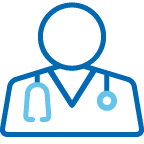PrEP: The key to preventing HIV spread

At a glance
- Anyone seeking STI screening should also discuss HIV risk with their provider
- PrEP can be up to 99 percent effective at preventing transmission
- PrEP is now available in oral and shot form to fit your needs
If you take anything away from reading this, Veronica Navarro, ARNP, FNP, hopes it’s that you know PrEP exists.
Pre-exposure prophylactics, or PrEP, is used to prevent the transmission of HIV. When taken as prescribed, it can be up to 99 percent effective — meaning it will be key in ending the HIV epidemic.
“With PrEP use, the whole community has an extra layer of protection by up to 60 percent reduction in HIV transmission,” says Navarro, an internal medicine provider for MultiCare Rockwood Clinic.
Navarro is one of four clinic-based HIV specialists in the Inland Northwest. She works closely with her colleague, Rachel Safran, MD, and the Spokane Regional Health District, to reduce the spread of HIV through education and prevention.
Their key message: The spread of HIV is more than just an individual health concern — it’s a public health issue.
In 2021, 461 new HIV cases were reported in Washington state. For several years prior to the COVID-19 pandemic, there had been a gradual decline in new HIV cases — but in recent years the numbers have either plateaued or increased.
To reverse this trend, the community must know their risks and options.
Who’s at risk?
Anyone seeking sexually transmitted infection (STI) testing should consider PrEP, or at least have the discussion, Navarro explains.
While men who have sex with men (MSM), as well as women and people of color, are at greatest risk, PrEP consideration should be based on your overall sexual activity and safe sex practices, she says. Being married or in a monogamous heterosexual relationship doesn’t eliminate risk.
It’s also important for those between the ages of 18 and 22 to recognize the risk that runs within their peer groups, Navarro adds. Cases in this demographic are commonly caught late, or only sporadically through urgent care clinics or school-based counselors.
And, of course, engaging in unsafe sex practices will always put you and others at risk of infection.
Know your options
If you’re at risk for HIV transmission or engage in activities that could put you at risk, know that you have options to protect yourself, Navarro stresses. Current treatments include a pill or shot.
The top recommended oral option is a once-daily pill. If that’s not an option for you, there are oral alternatives you can discuss with your provider.
For those who would rather take the shot, it’s becoming more readily available and covered by insurance providers.
Apertude is the only shot approved for PrEP, and recently received top recommendations from the U.S. Preventive Services Task Force, which means more insurance providers will cover the cost. The shot is given every other month, after the initial two-month dosage. It’s shown to be the most effective form of protection, with 18 months of consistent treatment.
Both options include additional requirements and regular lab testing your provider will review before prescribing.
Talk to your doctor
If you have any questions or concerns about your risk or current status, schedule an appointment with your doctor or other health care provider.
Your health includes more than just the physical body. If you’ve recently been diagnosed with HIV, the Spokane Regional Health District is available to help coordinate your care, provide testing and assist with mental health support, transportation, housing and food resources.
What's next
- Learn more about your STI risk and where to get screened
- Don’t let cost put you at risk — financial assistance is available
- HIV care has evolved to focus on promoting a long, thriving life for patients





